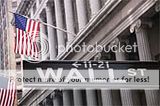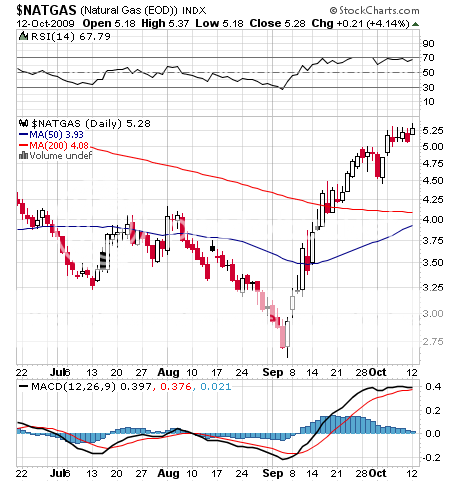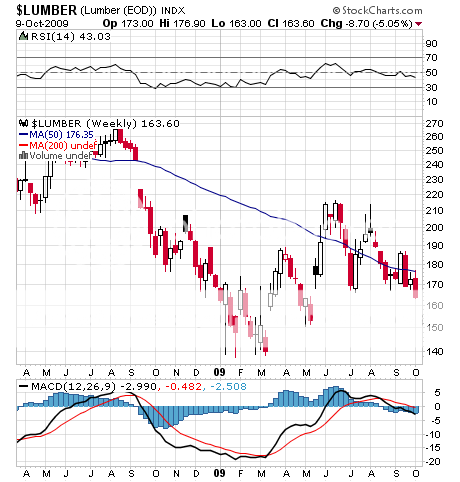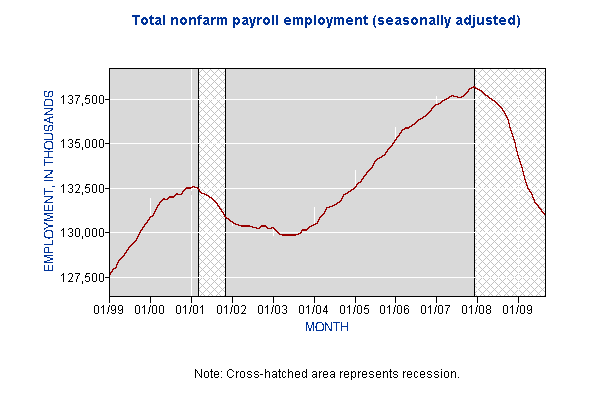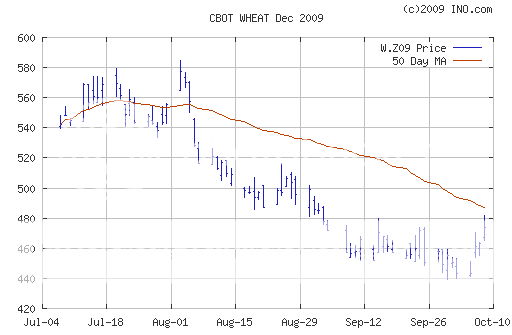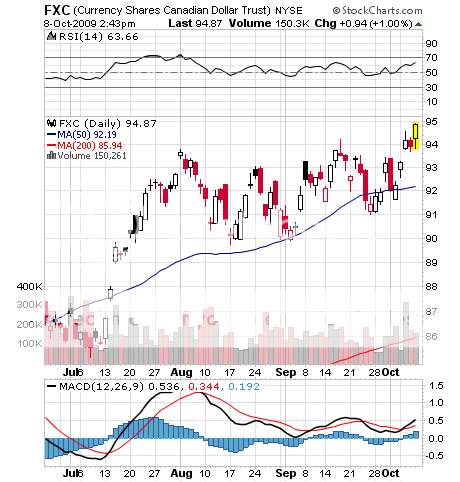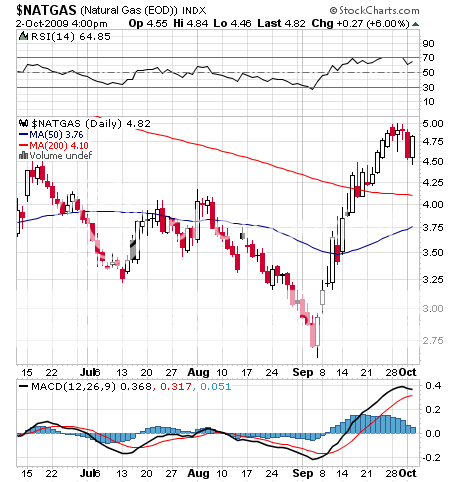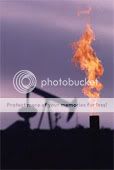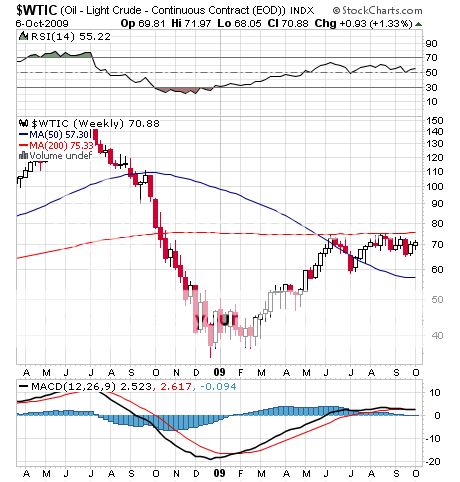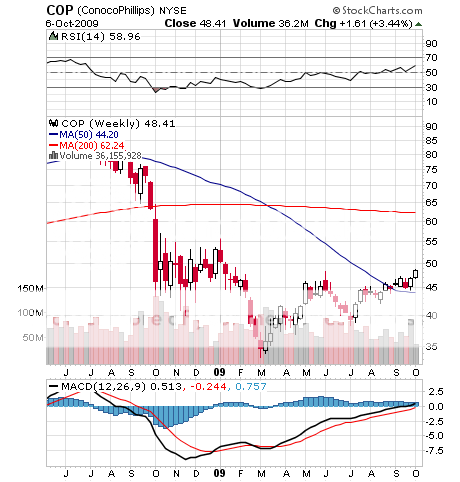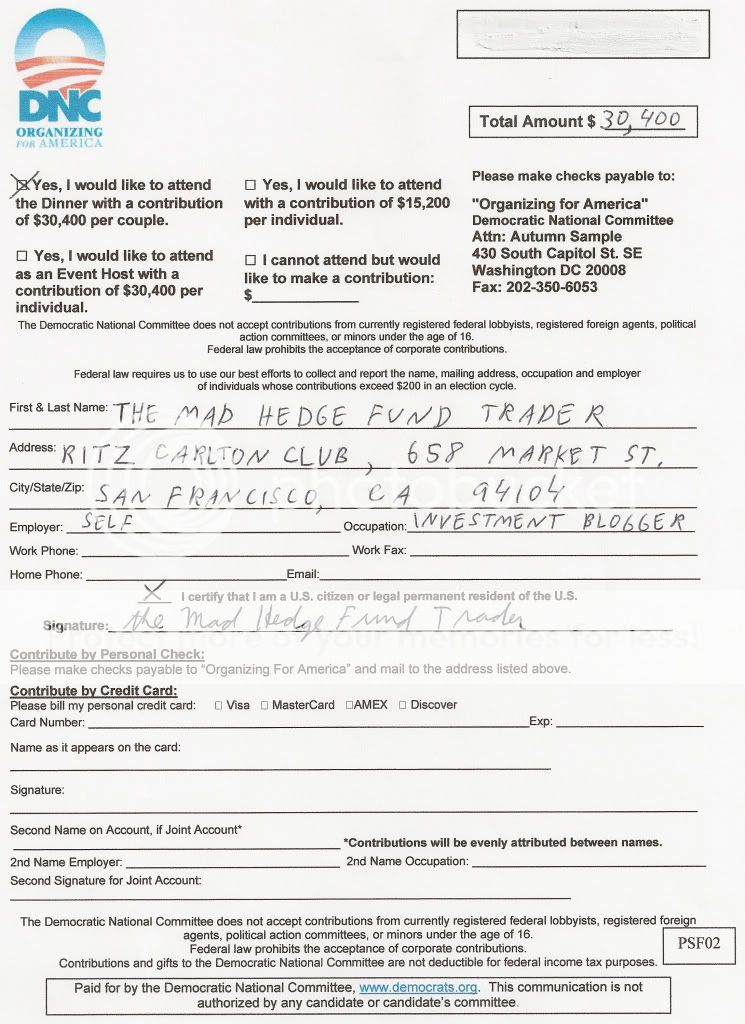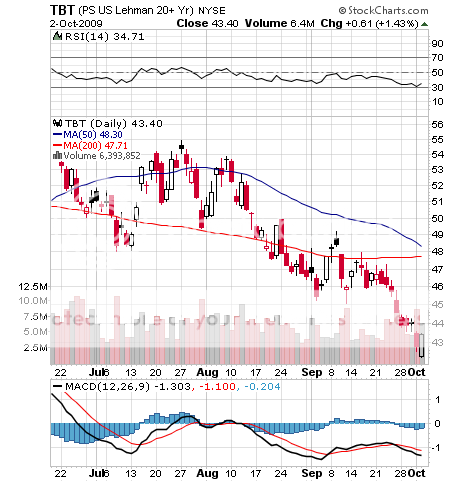
Global Market Comments
October 16, 2009
Featured Trades: (RESIDENTIAL REAL ESTATE), (ETF?s), (CALIFORNIA WINE MARKET)
1) I can honestly say that I have worked for the worst boss on the planet, Rupert Murdoch, when I free lanced for his flagship newspaper, The Australian. No matter what I wrote about Japan?s trade down under in sugar, wheat, coal, iron ore, steel, or uranium, it was always ?bloody awful,? even though I was usually accurate, timely and right (and cheap). His visits to Tokyo were a total nightmare, and since I was the only one in the organization then who spoke Japanese, the chore to escort him always fell to me. I can tell you that the grandfatherly Rupert you see today is a cheap, watered down Chinese imitation of the tyrant who terrorized us 30 years ago. When good people were fired, which was often, they were overwhelmed by an immense sense of relief. That rant aside, his newly acquired toy, the Wall Street Journal, still occasionally publishes some useful information. The October 5 issue ran a survey of websites for Exchange Traded Funds, the most popular and rapidly growing investment vehicle to come out so far this century.? ETF?s make possible narrow, rifle shot bets on specific, markets, sectors, currencies, and commodities in both long and short, and leveraged or non leveraged formats. They are the perfect securities for a guy like me who is constantly trolling the world for opportunities. Morningstar (click here)? is the most comprehensive, handing out star ratings, as it does with mutual funds. Tom Lydon?s ever helpful ETF Trends (click here) , offers a paid subscription service, which publishes 8-10 specific ETF recommendations a day, based on his own investment strategy, which is somewhat similar to my own. For a free ETF data base and directory you can go to the ETF Guide (click here) . To check out the WSJ piece in its entirety, please click here .
2) Since I have been pelted daily with predictions that residential real estate has bottomed for the last two years, like hail in a Midwestern summer thun derstorm, I feel a public duty to tell you that is just not the case. Now that the state and federal moratoriums are off, foreclosures are accelerating. There are over a million Option ARM and Alt-A loan resets about to hit the fan. Since many owners will not see positive equity in their homes in their lifetimes, banks are seeing more walk aways and keys mailed in, often with tearful letters attached. The run up in mortgage rates from 4.5% to 5.5% has yet to hit the market. Some 18 million homeowners divert 50% of their incomes to pay for housing, double the 25% that is considered healthy, and many of them are losing jobs at a record rate. While the volume of units sold has rebounded, the action is dominated by speculators, flippers, and bottom feeders bidding for properties at 10-40 cents on the dollar, not exactly a sign of health. I like to visit the plethora of open houses in my neighborhood, but always find the dead broker hanging from the showerhead a bit of a downer for a Sunday afternoon. Call me when Ozzie & Harriet Nelson come back to the market. I listened to industry insiders call the bottom of the Japanese real estate market for 15 years, until they finally died, and the market is still a fraction of its 1990 high. I think we are closer to the bottom than the top in terms of price, but closer to the top than the bottom in terms of time. You can take that to the bank.
3) One of the great things about living in Northern California is the proximity to Napa Valley, one of the world?s preeminent wine making regions. But as children frolicked in huge tubs of merlot at the annual fall grape stomping ritual, nothing but sour grapes could be heard among the vineyard owners huddled in small furtive groups.? The California? market has crashed, with premium Napa Valley cabernet fetching only half the $4,000/ton achieved only two years ago. The weather hasn?t helped, with alternating hot and cold spells shrinking the harvest by 10%-20%.? The glassy winged sharpshooter pest is an ever present risk, and there are still some holdouts of the phylloxera plague that forced most grapevine roots to be torn up two decades ago. Plunging prices and shrinking volumes do not make a great business model. Napa had its own version of the subprime boom, with nouveau riche pouring in to buy starter vineyards brandishing vanity labels-no experience required. Today foreclosures on these trophy properties are rampant, and you can buy them for a dime a dozen. CALPERS, the California State Pension Fund?s $200 million investment in the sector is starting to smell like a three day old bottle of Thunderbird, not fit for use as salad dressing. The new age of frugality has consumers migrating en masse to the low end of the market, leaving high priced labels like Opus One and Grgich Hills (made famous by the cute movie Bottle Shock) stranded in the marketplace. Central Valley winemaker and low end mass marketer, Charles Shaw, known locally and unaffectionately as ?Two Buck Chuck,? is making a fortune buying bulk wine at bankruptcy auctions for 50 cents a gallon, bottling it at his Napa plant, and knocking it out as low end supermarket wine with the Napa appellation for, well, $2. It?s a great time to expand your portfolio to investment grade wine. At least you can drink your mistakes.
October 15, 2009Featured Trades: (WHEAT), (WZ09), (HELEN THOMAS), (TROLL DOLLS)
1) I bet I?m the only guy you know whose wedding was filmed by the KGB. My friend, the TASS correspondent,? shot 8mm film of the entire assembled foreign press at the event at The Foreign Correspondents Club of Japan in the seventies, no doubt for their files in Moscow. No wonder they lost the cold war. We?ve stayed in touch through the years, through the collapse of the Soviet Union and the many wars, revolutions, booms, and busts that followed. He now advises a Russian hedge fund. What else? He called me the other day to tell me I was right on track with my recommendation to buy wheat (WZ09), because the Ukrainian grain crop had just come in 12% lower than last year. Poor weather had caused yields to plummet, and this would no doubt be good news not only for wheat, but corn and soybeans as well. The country was once known as the bread basket of Europe, which was one of the reasons why it was invaded by Napoleon in 1812 and the Germans in 1942. They still have a sizeable impact on global prices. I have also gotten an assist from my trading partner is the Midwest, one Jack Frost, whose early arrival has analysts slashing forecasts of grain crops here, leading to a 18% pop in price in the last week to $5.18/bushel. It?s even getting nippy hear in Fog City, where the roses in my front yard have commenced an early die off.?? I?ve noticed over the decades that when do the hard research and get your fundamental call right, all of the accidents and surprises tend to happen in your favor. That seems to be happening here.
2) One of the joys of having small children is that you get to know the guy at the local plumbing supply shop really well. It?s amazing what will fit down a toilet these days. He once told me that when Troll Dolls hit the market, every plumber in the country was guaranteed a job for life. When I went there yesterday I thought I?d pick up some leading economic indicators as well. After a deadly year, business is picking up a bit. Sure, it is still down a third from two years ago, but there is a definite improvement going on. The Eureka moment! His comments confirm the sort of ?L? or ?square root? shaped recovery I have been expecting. We aren?t going to zero anymore, but it is not exactly off to the races either. Throughout the nineties, a salesman at Circuit City (RIP) walked me through every generation of technology, and he was worth his weight in gold. All I had to do was buy a new TV from him every year, and they kept getting bigger and more expensive. I bought the second high definition TV sold in California, after George Lucas, who I used to run into at the local IHOP. Sometimes figuring out the direction of the economy is as simple as going down to the local butcher, baker, or candlestick maker and asking. They are on the front lines of economic activity, and they will see any changes months before those of us glued to computer screens. Asking George Lucas also helps.
3) I managed to catch up with my former white House Press Corp colleague, Helen Thomas, when her national book tour swung through San Francisco. At 89, Helen is the oldest and longest serving member of this esteemed group of journalists, and has the traditional right to ask the first question at each press conference. The native Kentuckian has covered every president since Kennedy, but has been observing the political scene since the Roosevelt era (Franklin, not Teddy). I knew her when I was a wet nosed apprentice writer during the Carter administration and she was a senior writer for the old United Press International. Helen hasn?t changed an iota, and is as feisty as ever. John F. Kennedy was her favorite president, a man of peace who knew war, who inspired people and launched the space program and the Peace Corp. Lyndon Johnson brought to life the most sweeping social programs since FDR?s New Deal, but saw his legacy shattered by the Vietnam War. She pitied Richard Nixon, who at the end felt the wrath of the nation fall upon his shoulders. Gerald Ford was a decent human being, too nice, really, for the job that was thrust upon him. Ronald Reagan was a master at managing the press. George W. Bush lied to the people about WMD?s in Iraq and hung the albatross of torture around America?s neck. He then sanitized the war for public consumption, and cowed the press into fearing being called unpatriotic and anti-American. Bush heard that Helen was murmuring that he was the worst president in US history, and broke with a century of precedent by conspicuously ignoring her seniority during his administration. Obama, who shares a birthday with Helen, lacks the courage to do the right thing and should stick to his guns. But all new presidents come in completely unaware of what they have signed up for and there is a tortuous learning process. Investigative reporting is gone forever because newspapers can?t afford it. Helen has seen public morals become more liberal for ourselves, but more strict for our public officials. I know there isn?t any real investment insight here, and I will probably get some angry e-mails from conservatives. But hey, when a piece of living history crosses your path, you grab on to her with both hands and shake her until the gems of insight she possesses fall loose. If Helen could only bottle and sell the energy she has at her age, she could make a fortune.
QUOTE OF THE DAY
?Seek the truth, and let the chips fall where they may,? Said Helen Thomas about her profession, adding ?I?m a cynic with hope.?
October 14, 2009Featured Trades: (NATURAL GAS), (CHK),
(DATA BASE SEARCH), (REGIONAL BANKS),
(DOLLAR BILLS)
1) I received another scratchy, crackling cell phone call from my drilling buddy in the Texas natural gas fields today. You could almost hear the dust on the line. The doubling of prices in the last month is totally bogus, and is nothing more than a short covering rally ahead of the seasonally strong run up to winter. Storage facilities are completely full, and while the production cutbacks have been substantial, they are still not enough. Some companies, like Chesapeake (CHK), are even suicidally boosting production in a desperate attempt to offset falling prices with jacked up volumes, at everyone else?s expense. This is all setting up a fabulous short selling opportunity, possible in early December, once the winter draws are priced in. There is still a huge risk that production will overwhelm storage as more new unconventional shale and tight gas deposits are brought on line, leading to another collapse in prices. A retest of the September lows is a gimme, and the $1 handle is still a possibility. So those of you who were nimble enough to bite a hunk out of the recent pop in CH4, better use any strength to cash in positions. I?d love to get more out of my friend, but I don?t think my aged, arthritic back could take another three hours driving down washboard roads in?? a beat up pickup truck with no springs.
2) Paid subscribers should be aware that you can use The Mad Hedge Fund Trader?s Data Base Search at any time by clicking here at http://madhedgefundradio.com/Data_Base_Search.html . Simply type in any stock symbol, company name, or individual name, and all references going back to February, 2008 will pop up. The original purpose was to enable potential investors to track what I was saying about specific markets, sectors, and securities over time, and see if I knew what I was talking about, or if I was just making it all up. I use it myself daily to track down data I know is lurking in there somewhere, like the number of BTU?s in a ton of coal, global electric power generation, or the price of cherries in California. The search engine is powered by Google (GOOG), so you will see text ads on the same topic cleverly placed alongside anything you find. The only limitation is that entries be at least three characters long. So instead of entering just ?X,? you?ll have to type in the full name ?US Steel.? I have in fact written about 350,000 words in the past 21 months, or about half the length of War and Peace. It took Tolstoy six years to write his epic about Napoleon?s invasion of Russia in 1812, and no one made a dime off of his stock tips. Try it, you?ll like it.
3) I have really been avoiding financials for the last few months after they had their dead cat bounces. However, I had to listen to MidSouth Bank CEO Rusty Cloutier when he spoke on CNBC. His 24 branch bank, with a market cap of only $103 million, is based in Lafayette, LA, one of my old stomping grounds, and home of the world?s greatest touff? and shrimp gumbo. He says that ?Unless we break up the big banks and get back to sound banking principles we are going to relive this over and over again??.Free enterprise has to have the right to fail??.Allan Greenspan and his administration have some problems they have to ??fess up to.? With the current system of megabanks ?They get the gain and we get the pain??.I?m regulated now by 13 agencies of the US government and I don?t know that I need a 14th.??? Regional Banks have really been taking it on the kisser this year, with 99 going under, four times the previous year?s rate. The FDIC has turned into an effective stealth undertaker, checking into local motels under assumed names, marching in at the Friday afternoon close with court orders in hand, and selling assets at fire sale prices to a healthy competitor by Monday morning. None of the government owned banks have been targeted by the federal agency yet. There?s no one who can read you a riot act like a Southern regional banker.
4) If you want to impress your friends with your vast knowledge of financial matters, then here are the Latin translations of the script on the backside of a US dollar bill. ?ANNUIT COEPTIS? means ?God has favored our undertaking.? ?NOVUS ORDO SECLORUM? translates into ?A new order has begun.? The Roman numerals at the base of the pyramid are ?1776.? The better known ?E PLURIBUS UNUM? is ?One nation from many people.? The basic design for the cotton and linen currency with red and blue silk fibers, which has been in circulation since 1957, carries enough symbolism to drive conspiracy theorists to distraction. An all seeing eye? The darkened Western face of the pyramid? And of course, the number ?13? abounds. Thank Benjamin Franklin for these cryptic symbols, and watch Nicholas Cage?s movie National Treasure. The balanced scales in the seal are certainly wishful thinking and a bit quaint. Study the buck closely, because there are going to be a lot more of them around.
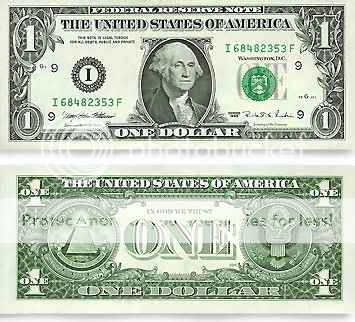
?By thinking at the 30,000-foot-level about asset classes, investors will get much better results from their portfolios,? said Steven M. Sears, vice president for asset allocation at PIMCO, the world?s largest bond fund.

October 13, 2009GLOBAL RISK ALERT!
Featured Trades: (GOLD), (SILVER), (CANADIAN DOLLARS), (AUSTRALIAN DOLLARS), (NEW ZEALAND DOLLARS), (BRAZIL), (RUSSIA), (INDIA), (CHINA), (TAIWAN), (SOUTH KOREA), (VIETNAM), (JNK), (TBT)
1) When everything is working, and my portfolio is firing on all 12 cylinders, I pinch myself and ask ?Is this real? What can go wrong?? I?m reminded of the slave whose task it was to remind conquering Roman generals ?All glory is fleeting.? Virtually all of my recommended core longs in gold, silver, Canadian, New Zealand, and Australian dollars, Brazil, Russia, India, South Korea, Taiwan, Vietnam, and?? junk bonds are at or near highs for the year. I called the bottom in Natural Gas within 40 cents, and mercifully baled on my one short in US government bonds, the TBT. What we are seeing is a global surge in liquidity as cash emerges from the bomb shelter, squints at the day light, and then rushes to buy the first thing it can find. Everything is going up, regardless of fundamentals. It is the proverbial tide that is lifting all boats. You can make a lot of money in these conditions, but there is no way of knowing if this will last for one week, or another year. But they can go on much longer than you think. In the last two liquidity driven markets I traded, Japan in the eighties and NASDAQ in the nineties, fundamental analysts railed against the tide for years, claiming that stocks were overvalued, each call getting their office moved ever closer to the elevator and men?s bathroom. When someone finally did throw the switch on these markets, it got dark amazingly fast. Tokyo went out at an all time high on the last day of 1989, and then dropped a staggering 45% in January. NASDAQ plunged just as fast from its 2000 top. The one thing we can all be certain about is that the survivors have vastly improved their risk control after our recent crash. Make hay while the sun shines, but keep your finger hovering over that mouse. The level of risk is definitely high than it was in March. When the next real downturn starts, it could resemble a flash fire in a movie theater.
2)?? I have to admit that I was stunned when the announcement hit the tape that Obama won the Nobel Peace Prize. I was sure he would get it, but not until he left office in 2012 or 2016. Even Obama admitted he didn?t deserve it. I happen to know the Swedish royal family quite well, as they invested in my hedge fund during the nineties. When I visited their money managers in Stockholm, I stayed at the Grand Hotel, where the Nobel winners are put up during the December ceremonies. On the wall of my suite hung original letters from fellow Californian and Nobel Prize winner in literature John Steinbeck. It turns out that more than 20% of?? the 829 Nobel Prizes have been awarded to Californians, thanks to the state?s massive investment in the sciences, 21 to UC Berkeley professors alone, including this year?s prize for economics. During the 100 year anniversary of the prize in 2004, all living Nobel winners in the state were invited to lunch with the Crown Princess Victoria, the Duchess of V??sterg??tland. I sat next to Milton Friedman and debated monetarism with the cantankerous University of Chicago economist for an hour. Swedes feel that since their country is small and relatively insignificant on the world stage, the Nobel Prizes are one of the few ways they can influence international events. By giving Obama an early prize, they are giving him a vote of confidence and attempting to give him some credibility in his dealings. Many countries certainly have every reason to be wary of his outstretched hand, given our recent history. The best news for Obama? The $1.5 million prize is denominated in Swedish kroner, which has been appreciating against the dollar. And no, I don?t have a Nobel Prize myself, at least until they start handing them out to hedge fund managers.
3) There?s nothing like getting up in the morning, sharpening your ax, taking off your shirt, and splitting a quarter cord of wood to get the blood flowing. I managed get the same invigorating effect by catching part of a nice 50% move in lumber futures earlier in the year, based on an expected recovery of exports to China (click here for my earlier call ). A wave of buyers followed me, heralding a recovery in the housing market, which I didn?t believe in for two seconds. Since June, the performance of the knotty, aromatic commodity has been definitely pekid. Listen hard and the trees are trying to tell us something. How are we supposed to have a recovery in the housing market with falling lumber prices? Are they building houses now without wood? Have I missed some great technological development in the home construction industry where termite proof houses are now all the rage? I think it?s much more likely that the Chinese topped up their inventories and the recovery in real estate is wishful thinking. Please take a look at the chart and tell me where I?ve gone wrong. If the trees are right, then real estate stocks, REIT?s, homebuilders, and even the banks are about to get slammed again. Is that smoke I smell?
?Sic transit gloria mundi?
For over a thousand years Roman conquerors returning from the wars enjoyed the honor of triumph, a tumultuous parade. In the procession came trumpeters, musicians and strange animals from conquered territories, together with carts laden with treasure and captured armaments. The conquerors rode in a triumphal chariot, the dazed prisoners walking in chains before him. Sometimes his children, robed in white, stood with him in the chariot or rode the trace horses. A slave stood behind the conqueror holding a golden crown and whispering in his ear a warning: that all glory is fleeting.
? Gen. George C. Patton
October 12, 2009 Featured Trades: (FBI),
(YELLOW CAKE), (CVX), (CRUDE)
1) I immediately recognized Robert Mueller as the kind of no nonsense, ex-Marine, Vietnam Vet that he was, the kind of officer who used to rip your? guts out for disobeying a direct order, which in my case was frequently. President Obama thought this is the man you want for your Director of the FBI, which is why Mueller survived as one of the few holdovers from the Bush administration. The Internet is not just a conduit for commerce, but also for crime and terrorism, and the bad guys are checking your doorknobs every day. Information is power, and fiber optic cable is a weapon. Terrorists, in particular, love the new Google Earth application. Only that morning, Mueller busted an American-Egyptian phishing ring, arresting 50, which looted 5,000 US accounts. We all must take ownership of the cyber security problem through the vigilant use of antivirus software, firewalls, sophisticated passwords, and constant patches. Tracing a 75 cent accounting discrepancy at UC Berkeley led to the smashing of a German industrial espionage ring that was tapping into university computers. Teenaged kids, like the Canadian who launched the biggest ?denial of service? attack against E-Trader and E-Bay, are to be feared. Be careful what you post on your Facebook page because it may kill a job prospect years down the road. The FBI is now embedding agents in police departments in Eastern Europe and China to take the fight global. When I got home, I immediately backed up all my files, reset my passwords, and bought my fourth antivirus program. I also installed bars on my windows and set booby traps on the front lawn for good measure.
2) I thought I?d pop next door to San Ramon and check in with Dave O?Reilly, the outgoing CEO of Chevron (CVX). The original Standard Oil of California, and one of the Seven Sisters, Chevron has a storied history. It discovered the legendary Ghawar field in Saudi Arabia in the thirties, the world?s largest, and later took over Gulf Oil (from Paul Getty), and Texaco. It is now the largest company in California.?? The problem for the US is that over the last 20 years demand has increased by 4 million b/d, while depletion has cut domestic production by 4 million b/d. The 8 million b/d gap can only be met with imports, which is why Chevron now earns 75% of its earnings from overseas, doing battle with Nigerian rebels and uncooperative foreign governments.?? The net net is that oil prices are going up. All alternative sources will need to be developed to deal with this widening gap, be it wind, solar, biofuel, or nuclear. Chevron is in fact the world?s largest producer of geothermal energy, accounting for 2% of its total supplies, is also the state?s largest installer of solar panels, and has invested $300 million in biofuel research. This is more than just ?feel good? money. The real impediment is that capital turnover in the energy industry is extremely slow. Coal fired power plants can last a century, and our 245 million cars last 15-18 years. Some of today?s low mileage clunkers will still be on the road in 2030. Even with the best efforts, Chevron will get three quarters of its revenues from oil in 2050. There is 100 years worth of investment in our current energy infrastructure and it won?t be replaced overnight. We will be lucky if we can cut CO2 emissions by 25% before 2050, a far cry from the Sierra Club?s 90% goal. The quickest way to cut emissions is to convert our coal fired power plants to natural gas. When Chevron took over Texaco in 2001, it inherited its legal headache in a $27 billion lawsuit over clean up of the Lago Agrio field in Ecuador, a hot button with environmentalists. Now David, a modest Irish engineer who came up through the research side of the company, has to be escorted by bodyguards at public events.

3) If we are just on the verge of entering a long term bull market for nuclear energy (click here for full report ), then you have to expect the same for nuclear fuel. Last year, the US consumed 55 million pounds of ?yellow cake? or uranium oxide (U3O8), but produced only 4 million pounds. The rest came out of stockpiles or from imports, much if it from the reprocessed Russian nuclear warheads. The new Department of Energy, under Dr. Stephen Chu, has made a big priority of making loan guarantees available to expand nuclear capacity from a lowly 20% of our total grid. The price of uranium is also rising, dragged up by crude, at one point popping 40% this year. The futures may be the better way to play this, as Uranium mining stocks are notoriously subject to manipulation, and are at the moment a tad expensive.?? In 2007, NYMEX started trading in uranium futures where one contract for 250 pounds is now worth 11,250. Good luck taking delivery is you aren?t running a nuclear power plant. You could be getting a midnight knock on your door from Robert Mueller.
?If you get an email from me, ignore it, especially if I am asking for money,? said Robert Mueller, Director of the FBI, who nearly fell victim to a phishing scam targeting his personal bank accounts.
October 9, 2009
Featured Trades: (BILL CLINTON),
(WHEAT), (CANADIAN DOLLAR),
(ALTERNATIVE ENERGY),
(ORCL), (TM)
1) I opened the e-mail at my usual wake up time of 4:00 am. President Bill Clinton was playing with Tiger Woods at the Presidents? Cup PGA tournament at the Harding Park Golf Course in San Francisco today. Would I have time for a chat about US economic policy afterwards? That afternoon, in walked Bill, sunburned from his morning on the links, to chew the fat with some Bay Area business leaders. I can?t say who else was there, but I?ll give you a hint: I was the only one without a NYSE listing. The US needs a new job engine every five to seven years to continue growing. Reagan had the personal computer, he had the Internet, but since then there has been nothing. As a result, new job creation fell from 23 million during his administration to a net job loss of 1.5 million during the Bush years (click here for BLS stats ), causing real standards of living to fall for two thirds of all Americans. The big challenge is how to bring back the economy without burning up the planet. $1 billion of new spending would create only 870 jobs in a conventional coal fired power plant, but 2,000 jobs for a solar plant, 3,300 for a wind facility, and 6,000 from improved building efficiencies. So creating a new job engine is a matter of political survival for Obama and the Democratic Party, and you can expect new subsidized alternative energy projects to be raining down upon us for the next three years, like hail in the Book of Exodus. Getting health care costs off the back of corporations is also essential for recovery. As things now stand, all of our net new economic growth is going to cover increased health care costs. And that only gets us an outcome that ranks 25th globally. Clinton now devotes himself to his Clinton Global Initiative, on non-profit which coordinates inter governmental cooperation in health care, education, and the environment, and has raised $57 billion for? new development projects (click here for? their website ). He was incredibly well informed, obviously still has access to confidential intelligence briefings, and rattled off statistics like an M60 machine gun. You really get the impression you are dealing with a Rhodes Scholar. I reminded him of the 1968 anti-war demonstration we both attended in London and he laughed. Wow! Invitations from both Obama and Clinton in the same week! Was it something I said?

2) Just a little note to let you know that my recommendation to buy December wheat (WZ09) is showing signs of life (click here for my initial call ). The perfect weather couldn?t continue forever. That was a mathematical certainty. The freezes this week started in Minnesota, moved over to the Dakotas, and have gone as far south as Iowa. Although it hasn?t affected the wheat crop as much as corn, since wheat is mostly in the silo, the change in the weather is a reminder to traders that this is not a one way trade, and it is time to cover shorts. It could also be that the strength in gold, silver, and the currencies means that the global liquidity tidal wave is reaching the further corners of the financial world, like the ags. Whatever the reason, the charts for all the grains appear to have bottomed and it may be time to start scaling in longs.
3) Another reminder that the Canadian dollar has gone ballistic today, decisively breaking through the $1.06 level, and the Looney is now on its way to parity with the greenback (click hear for my last recommendation). All aspects of the global commodity trade are now in full play, and with hurricane force winds behind us, the risk of a ?melt up,? where futures markets see lock limit moves up, is rising. Kudos to those who followed my advice all year to pour into the commodity currencies early. Run those positions. Be careful adding longs here because the risk is rising. I have been so negative on the dollar this year that I should have spurned the vanity of calling this ?The Diary of the Mad Hedge Fund Trader,? and instead named it the ?Why I Hate the Buck Daily,? or the ?Bail on America Digest.? If you can?t trade the futures, look at the chart below for the Canadian dollar ETF (FCX). And check out once more the gratuitous photo of my favorite Canadian, Pamela Anderson.

4) For those of? you whose 30 days trial subscription are about to expire, here is my calendar of meetings for the next month as an incentive to renew:
Barrack Obama, President of the United States
Bill Clinton, 43rd President of the United States
Robert Mueller-Director of the FBI
Leon Panetta-Director of?? the CIA
Larry Ellison? CEO of Oracle (ORCL)
Steve Lentz-President of Toyota (USA) (TM)
Ralph Nader-former presidential candidate and consumer advocate
Daryl Steinberg-President of the California State Senate
Stephen Levitt-Coauthor of? Freakonomics
Captain ?Sully? Sullenberger-the US Air pilot who landed in the Hudson
Helen Thomas-Senior correspondent of the White House Press Corp., and a former colleague of mine.
Michael Moore-Film maker whose invitation I turned down
Muammar Abu Minyar al-Gaddafi-President of Libya and Brother and Supreme Guide of the Revolution, who I missed because he was only in town two days and I couldn?t find his damn tent.
Watch this space!
?Alternative energy is the only way to restart the job engine,? Said Bill Clinton, the 43rd President of the United States.

October 8, 2009 SPECIAL NATURAL GAS ISSUE
Featured Trades: (UNG), ($NATGAS),
(CHK), (DVN), (USO), CRUDE), (COP), (PBR)
1)? Happy as I am to open beer bottles with my teeth and do my own tattoos, I have recently become a wimp when it comes to trading natural gas futures. I managed to warn my readers that a collapse of Biblical proportions was coming on June 2, when I recommended a sale at $4.40 (click here for the report ). Yes, you may fan me with ostrich feathers like a Middle Eastern potentate for that call. No, I did not predict a $1.90 bottom by throwing a dart at a dartboard. I simply called a half dozen buddies from my drilling days in the Texas Barnet shale and came up with a worst case cost of production of $2/MBTU. As it turned out we got a $2.40 bottom, and then a pop to $5/MBTU in a nanosecond, obviously the mother of all short covering squeezes. The industry is still on the horns of a massive dilemma. More than 100 years of supplies of CH4 have been discovered recently, but all of the main production companies may go under before we get much of it out of the ground if prices don?t stabilize. Virtually all natural gas storage facilities in the country are either full or locked up by hedge funds capitalizing on the massive contango, and it is impossible to export the stuff. Many shareholders have recently found religion, praying for a cold winter to balance out supply and demand. Long term, my bet is that the Pickens Plan (click here for my chat with the homespun Boone ) kicks in and pushes prices back up. If you still want to play where traders gulp down a quart of hot steaming volatility before breakfast every morning, e-mail me at www.madhedgefundtrader.com and I?ll tell you how to get set up. Just keep in mind, though, that you are moving into one of the toughest neighborhoods in the financial markets, where the ?widow maker? lives.

2) For an update on the Pickens Plan, I managed to catch the 81 year old Boone?s interview on CNBC yesterday, who spouted out statistics like the University of Oklahoma State University geology graduate that he is.?? After cutting through the love fest and the softball questions, I managed to get some actual facts out of it. Boone wants to target the country?s 6.5 million heavy trucks, converting them from diesel to natural gas on a replacement basis. These vehicles account for 2.5 million barrels a day of the 9.8 million barrels/day the US currently imports (click here for GOVT. stats) . To this end, he is pushing for the passage of the Natural Gas Act (HR 1835 and Senate bill 1408) which will create 18 year tax credits and subsidies for the production and use of natural gas vehicles along with the necessary infrastructure, like pipelines and pumps. His chances of success are good, as the last NG related bill, HR 1622, an appetizer sized $30 million five year project to promote NG, passed by an overwhelming 387 to 24. Of course, everything is on hold until health care passes, which may eat up the calendar for the rest of the year, so energy legislation will almost certainly be 2010 business. All of this is not soon enough for the industry, which is desperate for anything to keep their commodity from falling back to the mat.
3) T. Boone Pickens, CEO of BP Capital Managements, which manages three energy hedge funds, also made some interesting comments on oil. I worked with Boone on some of his ?pac man? oil company takeovers during the eighties when I was at Morgan Stanley, and he has been the best call on crude for the last 30 years. At least until last year, when the stunning speed of the crude collapse hit him squarely between the eyes, decimating his funds. Boone continues to ring the alarm bell about China. Its insatiable appetite for crude and other commodities led it to recently lock up 5 billion barrels in global reserves through foreign takeovers and partnerships, and that demand is only going to increase. During the last five years the Middle Kingdom?s consumption has soared from 3 million barrels/day to 8.1 million barrels/day, and half of that has to be imported. The super spike in oil prices is inevitable, unless the US does something radical to replace imports. With most reserves now controlled by foreign governments, the US is at risk of getting shut out of the oil market. Long time readers know that I have been a huge bull on crude prices since the beginning of the year when it traded at $32/barrel. The only question is how fast they will go up. If we do get a synchronized global economic recovery, then look out above! Single stock traders have Warren Buffet?s favorite, vertically integrated super major ConocoPhillips (COP) to look at, foreign stock investors should be focused on Petrobras (PBR), ETF players have the United States Oil Fund (USO), and if you want to play in the futures, where you can still get 7:1 leverage, then email me at madhedgefundtrader@yahoo.com to set up an account.
4) Note to subscribers: In view of the huge response I received on my upcoming dinner with President Obama, please e-mail me your favorite questions you would like me to ask him to madhedgefundtrader@yahoo.com.?? I will publish the top ten. Can?t guarantee you I will get all the answers though.
?It?s the labor market that is going to end the recession, and that?s not going to happen any time soon,? said Richard Suttmeier, the chief market strategist at ValueEngine.com.
October 6, 2009
Featured Trades: (OBAMA), (FSLR), (SOLAR)
1) If you wonder where I am on the evening of Thursday, October 15, I will be having dinner with Barrack Obama, President of the United States. I received the invitation to San Francisco?s exclusive Saint Francis Hotel to meet the Commander-in-Chief with 250 of the city?s ?A-listers,? which I have reproduced below. Of course $30,400 for two is a bargain to sit down with the most powerful man in the world, but that doesn?t include another $10,000 for my date?s dress. I have been asked to arrive two hours early to provide for security screening. With my opinions plastered all over the Internet, that will no doubt involve a full proctologic exam. But hey, anything for some overcooked chicken.? Times are hard, and we all have to do our bit to stimulate the economy. Maybe I should go for a table of ten for only $150,000? Until then I shall be boning up on subjects I know are dear to the President?s heart to make chit chat, like playoffs for college football, or how he got stiffed in his Chicago Olympic bid. He could have made such a killing renting out his Hyde Park house that I visited last December (click here for story ), which would have been walking distance from many of the events! How much do you think I should leave for a tip?
2) Solar is about to become a big part of our lives, as it careens toward long sought profitability, and it will suit you to learn more about it. To get a good introduction to the industry, both through some good engineering statistics and some great pictures, then check out the September edition of National Geographic magazine by clicking here . Total world electricity demand today is 16 terawatts (16,000 megawatts), and that is expected to grow to 20 terawatts by 2020. Solar comes in two flavors, thermal and photovoltaic (PV). Thermal is the old dinosaur technology, with thousands of convex mirrors arrayed to heat piped oil, which is then used to power a conventional steam power plan, converting about 24% of the sun?s energy into electricity. The future is with photovoltaic solar, which uses the semiconducting ability of silicon to grab electrons directly from sunlight. PV is less efficient at a 10% conversion rate, more expensive, but is making great leaps forward. It would only take 100 square miles of PV panels placed on rooftops to meet all of the electricity demands of the US. The final goal is to develop silicon paint which you then apply to your house to generate power, all for the cost of a bucket of regular paint. PV chips in the lab are already achieving efficiencies of 40%. First Solar (FSLR) now owns the cutting edge with its thin film panels, a company I have written about extensively (click here for the report ). It is also a great trading vehicle, with plenty of volatility, and the recent silicon panel price war with China has knocked the stock down into ?buy? territory. The additional of FSLR to the S&P 500, the first alternative stock to do so, is the writing on the wall. I regularly mine this magazine for long term technology and environmental trends, and my kids love cutting up the pictures. After all, it was founded by one of the original venture capitalists, Alexander Graham Bell, the inventor of the telephone.
3) If anyone wants an update of my current iconoclastic, out of consensus, even ?Mad? views of the global financial scene, check out my interview published by the cutting edge online newsletter, Phil?s Stock World, by clicking here . It will save me a dozen pages of writing to you. Phil runs his own US equity option trading operation with a premium subscription service, and tacks on an aggregation of several other high end blogs, like Zero Hedge, Chart School, Andrew Wilkinson, and the Oxen Group. More about Phil?s efforts later.
?Whenever you find yourself on the side of the majority, it?s time to pause and reflect,? said Samuel Clemens, also Mark Twain.

October 5, 2009 SPECIAL ?I TOLD YOU SO? ISSUE
Featured Trades: (TBT),
(BRAZIL), (EWZ)
1) For the last six months there has been a great big whopping contradiction in the markets. The stock market has been discounting a return to the ?Roaring Twenties,? while the bond market has been anticipating another ?Great Depression.? After yesterday?s publication of the Labor Department?s September nonfarm payroll number showing the loss of another 263,000 jobs, it looks like the bond market now has the upper hand. This takes the unemployment rate up 0.1% to 9.8%, and total job losses for this recession to 7 million. The really disturbing aspect of this number is that 57,000 teachers were fired, as states chop budgets to the bone. This is really eating our seed corn by the bushel full. Of course, I have been banging pots and pans, setting off distress flares, and yanking the fire alarm, trying to alert readers that this kind of disappointment was coming. Shares have dropped 5% from last week?s peak, as the bond market soared, the ten year yield reaching nosebleed territory of 3.05%. The dollar maintained its flight to safety status, which to me is one of the great ironies of all time. It?s like that reprobate, alcoholic uncle with the bad teeth, who, when your car breaks down in the middle of a downpour in a bad neighborhood, will always let you crash on his sofa. Let?s call him your Uncle Sam. You have to hand it to PIMCO?s inveterate card counter, Bill Gross, who says this is all about transitioning to a ?new? normal of 1%-2% real GDP growth. That?s why he was loading the boat with bond yields at 4%, a ?ballsey? move at the time, which now smells like roses. I guess that?s why they call him the ?Bond King.?
2) In light of the disappointing September nonfarm payroll figures reported yesterday, I?m afraid that my recommendation to buy the Proshares Ultra Short Treasury Trust (TBT), a bet that US Treasury bonds are going down, is starting to look a little green around the gills. I first recommended the TBT at the beginning of the year (click here for report ), catching a nice run from $35 to $60, and then told investors to bail at $60. I have since advised readers to start scaling back in around $45. It traded down to $43 yesterday and is at risk of turning from a trade into an investment. Of course, the fundamentals behind the TBT are still as valid as ever. Treasury bonds are without a doubt the world?s most overvalued asset, and the only political certainty we can count on is the continued exponential growth in the supply of government bonds of all maturities. Like all Ponzi schemes, their eventual collapse is just a matter of time. But as the noted economist, John Maynard Keynes, liked to remind his students, ?Markets can remain irrational longer than you can remain liquid.??? Better to live to fight another day. If you have the TBT, keep some mental stop losses under the markets, as ETF?s don?t offer owners the real thing. If the economy does enter the second half of a ?W,? the sushi could really hit the fan. As for me, I?m never wrong, just early. Sometimes way early.
3) Hoping to beat the rush, I ordered my Rosetta Stone Portuguese language program last week, fully expecting Rio de Janeiro to win the 2016 Olympics bid. Pick pockets of the favellas of Latin America?s largest city were ebullient. A cheer even went up on the floor of Chicago?s CME, now that the denizens of the Windy City are dodging a monster tax bill. Of course, Obama was in a no win situation, with mud on his face for his failed pitch, and blamed for defeat if he didn?t go. There was never any doubt that the home of the string bikini and the banana thong was going to win. In order to justify the gargantuan cost of the modern games, the International Olympic Committee long ago turned this into an emerging market development program. The great news for investors is that corresponding emerging stock markets have a history of tenfold returns going into the games. Look at South Korea and China. Only the 2004 Athens games were a bust, the home of the Olympics building a games that were far more than it could afford. I have long been a fan of the country that is doing everything right, with a perfect demographic pyramid and a liberal pro business government fueled by resource and energy exports. I managed to catch a 270% leap for my subscribers in the ETF (EWZ) this year. I wouldn?t? rush out tomorrow and buy on the news, as an impending global stock market selloff is likely to pull it down with everything else. But it definitely should be at the top of your ?buy on dips? list.
4) Since energy is going to be the dominant factor in making our investment decisions for the next decade, I thought it would be a good time to sit down with Carl Pope, Executive Director of the Sierra Club. Carl, who makes frequent appearances in this week?s PBS broadcast on the National Parks, is as sharp as a tack, with the fervor of an evangelist-always a dangerous combination. In the spirit of full disclosure, I have to tell you that I was a member of the Sierra Club back in the sixties when they were mostly interested in identifying mountain wildflowers and bird calls. They changed a little after that. Carl says that the ?Earth has a fever,? with temperatures rising, glaciers melting, forests burning, oceans rising and acidifying, and the overwhelming cause is hydrocarbon burning. The US needs to cut CO2 emissions to 2 tons per person, per year, by 2050, or down 90% from today?s levels. To do this we need to ban the burning of coal by 2030, unless it is sequestered, and stop all petroleum consumption by 2040. We can accomplish this by converting all cars to electric and moving freight via an electrified rail system. Petroleum needs to be classified as toxic waste, and a cleanup superfund needs to be set up, funded by 10% of the earnings of the oil companies for the next ten years. If we eliminate oil consumption, our trade deficit will improve by $100 billion/year, that money can be invested in the US to create 10 million jobs, and we will all be a lot healthier. The biggest and quickest way to cut CO2 emissions is to convert all coal fired power plants to natural gas immediately, and Carl likes the Pickens Plan (click here for the full analysis ). Carl is not shy about using his 40 man Washington DC office to twist the arms of recalcitrant Senators and Congressmen to achieve these ambitious goals. I had to pinch myself. The Sierra Club has backed off from its earlier, more radical positions, and that some of what they are saying actually economic sense. No more going back to a bicycle based economy. Does he know he is also advocating a strong dollar policy? While 40 years is not exactly tomorrow, look how fast the last 40 have gone by. Remember pedal pushers, thin ties, fins on Chevy?s, and the Bay of Pigs? When contemplat
ing your risk positions, you always have to consider all views. Who knew that $147/barrel would turn us all into environmentalists?
?If we don?t get our macro house in order, it will put the dollar in danger, and the most critical element there is long term fiscal stability,? said Chairman of the Federal Reserve, Ben Bernanke.





